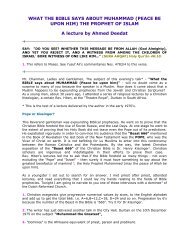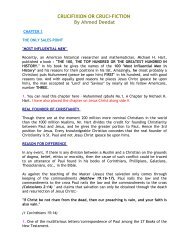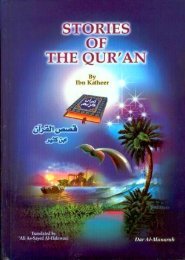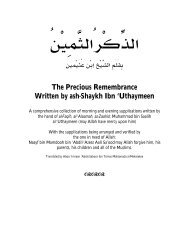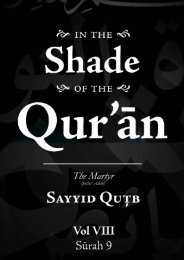- Page 4 and 5:
Setting Practical Examples ........
- Page 6 and 7:
The Lord of Mankind ...............
- Page 8 and 9:
SŪRAH 78Al-Naba’(The Tiding)ijkI
- Page 10 and 11:
(a fitting recompense. (26)They did
- Page 12 and 13:
Al-Naba’ (The Tiding)how they are
- Page 14 and 15:
Al-Naba’ (The Tiding)Prophet’s
- Page 16 and 17:
Al-Naba’ (The Tiding)21-30) The s
- Page 18 and 19:
Al-Naba’ (The Tiding)with the out
- Page 20 and 21:
Al-Naba’ (The Tiding)light. It al
- Page 22 and 23:
Al-Naba’ (The Tiding)We then have
- Page 24 and 25:
SŪRAH 79Al-Nāzi`āt(The Pluckers)
- Page 26 and 27:
4‘I am your supreme Lord’, he s
- Page 28 and 29: Al-Nāzi`āt (The Pluckers)surprise
- Page 30 and 31: Al-Nāzi`āt (The Pluckers)then he
- Page 32 and 33: Al-Nāzi`āt (The Pluckers)heard th
- Page 34 and 35: Al-Nāzi`āt (The Pluckers)with the
- Page 36 and 37: Al-Nāzi`āt (The Pluckers)earth sp
- Page 38: Al-Nāzi`āt (The Pluckers)those wh
- Page 44 and 45: `Abasa (The Frowning)create him? Of
- Page 46 and 47: `Abasa (The Frowning)its own weight
- Page 48 and 49: `Abasa (The Frowning)try to persuad
- Page 50 and 51: `Abasa (The Frowning)certain societ
- Page 52 and 53: `Abasa (The Frowning)Nasā’ī.]
- Page 54 and 55: `Abasa (The Frowning)`Umar sent Amm
- Page 56 and 57: `Abasa (The Frowning)the sense of h
- Page 58 and 59: `Abasa (The Frowning)of what it mea
- Page 60 and 61: `Abasa (The Frowning)respective pos
- Page 62 and 63: for what crime she was slain, (9)wh
- Page 64 and 65: Al-Muţaffifīn (The Stinters)secur
- Page 66 and 67: Al-Muţaffifīn (The Stinters)When
- Page 68 and 69: Al-Muţaffifīn (The Stinters)When
- Page 70 and 71: Al-Muţaffifīn (The Stinters)by th
- Page 72 and 73: Al-Muţaffifīn (The Stinters)becko
- Page 74 and 75: (Shun it! But you deny the Last Jud
- Page 76 and 77: Al-Infiţār (Cleaving Asunder)of w
- Page 80 and 81: Al-Infiţār (Cleaving Asunder)subs
- Page 82 and 83: Al-Infiţār (Cleaving Asunder)prud
- Page 84 and 85: SŪRAH 83Al-Muţaffifīn(The Stinte
- Page 86 and 87: 4witnessed by those who are closest
- Page 88 and 89: Al-Muţaffifīn (The Stinters)that
- Page 90 and 91: Al-Muţaffifīn (The Stinters)socie
- Page 92 and 93: Al-Muţaffifīn (The Stinters)there
- Page 94 and 95: Al-Muţaffifīn (The Stinters)by th
- Page 96 and 97: Al-Muţaffifīn (The Stinters)they
- Page 98 and 99: Al-Muţaffifīn (The Stinters)and h
- Page 100 and 101: and return rejoicing to his people.
- Page 102 and 103: Al-Inshiqāq (The Rending)read to t
- Page 104 and 105: Al-Inshiqāq (The Rending)account f
- Page 106 and 107: Al-Inshiqāq (The Rending)soul is o
- Page 108 and 109: SŪRAH 85Al-Burūj(The Constellatio
- Page 110 and 111: But God surrounds them all. (20)∩
- Page 112 and 113: Al-Burūj (The Constellations)for
- Page 114 and 115: Al-Burūj (The Constellations)do no
- Page 116 and 117: Al-Burūj (The Constellations)of Go
- Page 118 and 119: man shall be helpless, with no supp
- Page 120 and 121: Al-Ţāriq (The Night Visitor)This
- Page 122 and 123: Al-Ţāriq (The Night Visitor)“Ma
- Page 124 and 125: 4SŪRAH 87Al-A`lā(The Most High)ij
- Page 126 and 127: Al-A`lā (The Most High)The Prophet
- Page 128 and 129:
Al-A`lā (The Most High)This basic
- Page 130 and 131:
Al-A`lā (The Most High)stream may
- Page 132 and 133:
Al-A`lā (The Most High)arrangement
- Page 134 and 135:
Al-A`lā (The Most High)than the fa
- Page 136 and 137:
Al-A`lā (The Most High)He had a tu
- Page 138 and 139:
Al-A`lā (The Most High)kindness.Ea
- Page 140 and 141:
Al-A`lā (The Most High)countless m
- Page 142 and 143:
Al-A`lā (The Most High)origin: God
- Page 144 and 145:
in a sublime garden, (10)∩⊇⊃
- Page 146 and 147:
Al-Ghāshiyah (The Enveloper)The ad
- Page 148 and 149:
Al-Ghāshiyah (The Enveloper)cleanl
- Page 150 and 151:
Al-Ghāshiyah (The Enveloper)and ma
- Page 152 and 153:
SŪRAH 89Al-Fajr(The Dawn)ijkIn the
- Page 154 and 155:
4and your Lord comes, with the ange
- Page 156 and 157:
Al-Fajr (The Dawn)opening groups to
- Page 158 and 159:
Al-Fajr (The Dawn)specific mission.
- Page 160 and 161:
Al-Fajr (The Dawn)others] greedily,
- Page 162 and 163:
Al-Fajr (The Dawn)Once their errone
- Page 164 and 165:
SURAH 90Al-Balad(The City)ijkIn the
- Page 166 and 167:
Al-Balad (The City)Qur’ān, with
- Page 168 and 169:
Al-Balad (The City)climbing his own
- Page 170 and 171:
Al-Balad (The City)For what else ar
- Page 172 and 173:
Al-Balad (The City)beating you beca
- Page 174 and 175:
SŪRAH 91Al-Shams(The Sun)ijkIn the
- Page 176 and 177:
Al-Shams (The Sun)construction, by
- Page 178 and 179:
Al-Shams (The Sun)ruined is the one
- Page 180 and 181:
Al-Shams (The Sun)messenger had war
- Page 182 and 183:
We shall smooth the way to afflicti
- Page 184 and 185:
Al-Layl (The Night)However unbeliev
- Page 186 and 187:
Al-Layl (The Night)affliction worse
- Page 188 and 189:
SŪRAH 93Al-Đuĥā(The Morning Hou
- Page 190 and 191:
Al-Đuĥā (The Morning Hours)heart
- Page 192 and 193:
Al-Đuĥā (The Morning Hours)cessa
- Page 194 and 195:
Al-Sharĥ (The Solace)Hours, as if
- Page 196 and 197:
SŪRAH 95Al-Tīn(The Fig)ijkIn the
- Page 198 and 199:
Al-Tīn (The Fig)between this detai
- Page 200 and 201:
SŪRAH 96Al-`Alaq(The Germ-Cell)ijk
- Page 202 and 203:
Al-`Alaq (The Germ-Cell)cave of Ĥi
- Page 204 and 205:
Al-`Alaq (The Germ-Cell)recipient o
- Page 206 and 207:
Al-`Alaq (The Germ-Cell)never lose
- Page 208 and 209:
Al-`Alaq (The Germ-Cell)God who is
- Page 210 and 211:
Al-`Alaq (The Germ-Cell)able to do
- Page 212 and 213:
Al-`Alaq (The Germ-Cell)must refer
- Page 214 and 215:
SŪRAH 97Al-Qadr(Power)ijkIn the Na
- Page 216 and 217:
Al-Qadr (Power)the Qur’ān, so th
- Page 218 and 219:
4SŪRAH 98Al-Bayyinah(The Clear Pro
- Page 220 and 221:
Al-Bayyinah (The Clear Proof)ways u
- Page 222 and 223:
Al-Bayyinah (The Clear Proof)of the
- Page 224 and 225:
Al-Bayyinah (The Clear Proof)was ar
- Page 226 and 227:
Al-Bayyinah (The Clear Proof)lit an
- Page 228 and 229:
Al-Bayyinah (The Clear Proof)pleasu
- Page 230 and 231:
Al-Zalzalah (The Earthquake)Overvie
- Page 232 and 233:
Al-Zalzalah (The Earthquake)In a sp
- Page 234 and 235:
and what is in the breasts is broug
- Page 236 and 237:
Al-`Ādiyāt (The Coursers)that whe
- Page 238 and 239:
shall have the abyss for his home.
- Page 240 and 241:
SŪRAH 102Al-Takāthur(Rivalry for
- Page 242 and 243:
Al-Takāthur (The Rivalry for World
- Page 244 and 245:
Al-`āşr (The Declining Day)Faith
- Page 246 and 247:
Al-`āşr (The Declining Day)instea
- Page 248 and 249:
Al-`āşr (The Declining Day)what i
- Page 250 and 251:
Al-`āşr (The Declining Day)of gre
- Page 252 and 253:
Al-`āşr (The Declining Day)him an
- Page 254 and 255:
(SŪRAH 104Al-Humazah(The Slanderer
- Page 256 and 257:
Al-Humazah (The Slanderer)structure
- Page 258 and 259:
Al-Fīl (The Elephant)The various r
- Page 260 and 261:
Al-Fīl (The Elephant)is a fact ack
- Page 262 and 263:
Al-Fīl (The Elephant)their bodies,
- Page 264 and 265:
Al-Fīl (The Elephant)and diverse p
- Page 266 and 267:
Al-Fīl (The Elephant)people. God,
- Page 268 and 269:
Al-Fīl (The Elephant)worship of cr
- Page 270 and 271:
Al-Quraysh (The Quraysh)When the pe
- Page 272 and 273:
SŪRAH 107Al-Mā`ūn(Small Kindness
- Page 274 and 275:
Al-Mā`ūn (Small Kindness)“Have
- Page 276 and 277:
SURAH 108Al-Kawthar(Abundance)ijkIn
- Page 278 and 279:
Al-Kawthar (Abundance)millions of h
- Page 280 and 281:
SŪRAH 109Al-Kāfirūn(The Unbeliev
- Page 282 and 283:
Al-Kāfirūn (The Unbelievers)When
- Page 284 and 285:
Al-Kāfirūn (The Unbelievers)monot
- Page 286 and 287:
Al-Naşr (Divine Help)praises are d
- Page 288 and 289:
Al-Naşr (Divine Help)and it is He
- Page 290 and 291:
Al-Naşr (Divine Help)Thus, upon be
- Page 292 and 293:
Al-Masad (Fire Flames)Messenger sen
- Page 294 and 295:
Al-Masad (Fire Flames)This extremel
- Page 296 and 297:
Al-Ikhlāş (Purity of Faith)princi
- Page 298 and 299:
Al-Ikhlāş (Purity of Faith)the le
- Page 300 and 301:
SŪRAH 113Al-Falaq(The Daybreak)ijk
- Page 302 and 303:
Al-Falaq (The Daybreak)“From the
- Page 304 and 305:
Al-Falaq (The Daybreak)refuge in th
- Page 306 and 307:
Al-Nās (Mankind)and protects manki
- Page 308:
Al-Nās (Mankind)This is the most p



